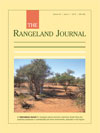RJ12067Landscape ecology: its role as a trans-disciplinary science for rangeland sustainability
This paper reviews the contribution that landscape ecology can make to sustainable rangeland management. Traditionally in places like Australia an ecological construct has been applied to landscape management. Recent shifts in the landscape ecological paradigm towards an approach that links science and practice with a particular focus on landscape design, social and cultural aspects of landscapes and the value associated with landscape services, make landscape ecology increasingly more useful for addressing rangeland sustainability and therefore this paper suggests that those involved in rangeland management consider landscape ecology within its wider context.




